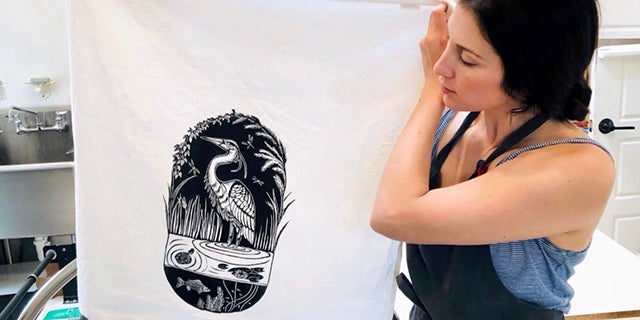Catfish Row Museum to host block print classes for kids, adults
Published 6:41 pm Wednesday, January 10, 2024

- Kate Hamel Tucker, owner of Owl House Designs in Mound, will be sharing her craft over two art classes at Catfish Row Museum in Vicksburg over the next week and a half (submitted photo).
By Jim Beaugez
Visual artist Kate Hamel Tucker became enthralled with science and nature as a kid growing up in Texas, observing the world around her and listening to the cicadas and frogs at night. But it was nothing compared to the near-nightly symphony she now hears at her home near Mound, La.
“When they’re all together,” she says, “it’s a pretty unique sound.”
As the owner of Owl House Designs, which she runs out of her home studio, Tucker has combined those interests with her love for block printmaking, an artform she discovered while attending the University of Virginia, where she earned degrees in studio art and environmental science.
Local Louisiana fauna like alligators, crawfish, turtles, frogs and opossums have all wormed their way into Tucker’s art, alongside pieces featuring a blue heron that hangs out nearby. “I’ve always been interested in ecology and wildlife, and where we’re living now we’re actually right on the bayou, so on any given day I’m seeing a lot of wildlife,” she says. “That’s a big inspiration.”
Tucker’s artistic journey began when she was a child, as she would try to recreate the illustrations she saw in books. Many of her block prints today also originate as freehand sketches, which she transfers to wooden blocks and carves with a gouge, a handheld tool similar to a small chisel.
Once she creates a block—based on her wildlife sketches or folklore-inspired designs—she prints them onto greeting cards, clothing, ornaments, stickers, tea towels and woodcuts using non-toxic inks.
“I love this intersection between science and folklore, because back in the day folklore was the way that people related and explained their world,” she says.
The practice of block printing began centuries ago in China and spread throughout eastern Asia as a means of communicating, chronicling history and passing along religious texts. Examples of block printing later appeared in parts of northern Africa and then Europe, where it offered an alternative to the more expensive printing press.
American artists have also used these techniques, including Walter Inglis Anderson of Ocean Springs, who created more than 300 linoleum block prints of coastal scenes and wildlife in the mid-1940s that his family used to create prints until 1985.
While the art of wooden block printing is one of the most influential techniques in human history, it is not widely taught outside of specialized programs.
“Typically, in school people get to color, they get to draw, sometimes they get to paint [or] do some collages, but printmaking is a little bit more of a skillset thing,” she says. “And so I think it’s something that a lot of people just haven’t been exposed to.”
Tucker will share her craft during two art classes at Catfish Row Museum in Vicksburg over the next week and a half, including a class for adults this Saturday, Jan. 13, and a class geared for kids Sat., Jan. 20. She notes that although trained artists will appreciate the classes, no prior artistic experience is needed. The kids’ class gives parents an opportunity to learn alongside their children, and Tucker recommends they wear old clothes and bring T-shirts for their prints.
“I’m happy to introduce other people to printmaking, especially kids, because I think it’s a great way to express yourself,” she says. “It’s a really good mix of creativity and process, and I feel like that can be a really good kind of stress relief and an outlet.”
For more information on upcoming events at Catfish Row Museum, visit https://catfishrowmuseum.org/.





